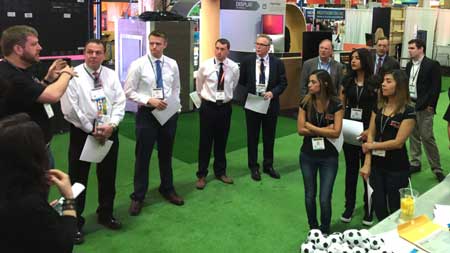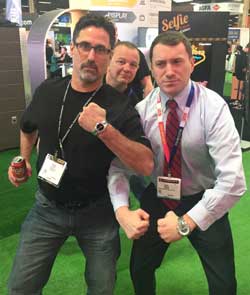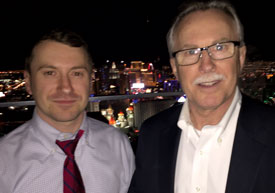When Adam Yorston looks back on the career path that has seen him rapidly rise through the ranks of Yorston & Associates, he cites the example set by his father, Bill, as a major contributor to his early success.
After graduation from the New York Institute of Technology with a degree in architecture, the elder Yorston has been active in the sign industry for more than three decades. Beginning his career as a sales associate with Wrisco Industries in Linden, New Jersey, he then established Yorston & Associates, a prestigious manufacturer’s representative firm that serves the sign industry.
It’s during those more than three decades that Bill Yorston has been setting examples for his son. “We have a tremendous relationship,” Adam Yorston says. “My father is self-taught but possesses a natural skill when it comes to doing what he does for a living. On top of that he’s never stopped learning.” With that example to follow, Yorston has, at the age of 28, carved out his own position with the Hellerton, Pennsylvania-based agency.
A position with the agency was not his first career stop, however. “If I had been asked at age 10 what I wanted to do for a living, I probably would have said something like hockey player. By age 12, however, I knew that wasn’t going to happen. In addition, for my first job, I wasn’t going to be a guinea pig to see if I could make it in my father’s business. My father’s plan was for me to go out and find a job on my own and make sure I could be successful.”
Beginning in Real Estate
And successful he was, in the world of real estate. As he explains: “My siblings weren’t really involved in the agency. As a result, my father figured if I wanted to be involved in the agency then I had to get experience elsewhere before joining him.” That’s exactly what he did.
Yorston notes that experience in real estate at the beginning of his career provided him with two important takeaways that have served him well in the agency business. “The first was the importance of follow-up and the second was networking or developing contacts. With both real estate and the agency business, you’re in touch with people who are already in the market for a purchase. They’re all coming to you for various reasons, including simply to pick your brain. That’s why it’s so important to maintain those contacts and get back to people as soon as you’ve got the information they’re looking for, or answers to the questions they’ve asked.”
After completing what might be considered a business apprenticeship in the real estate industry, Yorston explains he followed up on his desire to become an independent manufacturers’ representative. “What always inspired me to become a rep was the fact I wanted to do what my father did. I was also attracted to the chemistry needed to create a line card. You simply can’t add something to what you sell and hope to be successful. You’ve got to put products together that belong together. It’s a bit like putting the pieces of a puzzle together in order to provide the customer with a whole solution to their problem.”
Then there’s the part of the winning equation that calls for the agent to be knowledgeable about what he’s selling. “You’ve got to be well grounded in the niche you’re serving and in the products that you sell.”
Asked how and why his father ever gravitated to the signage industry, Yorston explains that it’s just one of those accidents of timing. “My father went to school to study architecture. Out of necessity he began work immediately after completing his education and ended up selling raw sheet aluminum for roofing, tractor trailers, etc. From there he identified a need for pre-painted, custom-color products for signage. He began to acquire lines and today we sell raw, semi-painted and even finished goods.
“From the signage standpoint that our agency specializes in, we’re knowledgeable about all the moving parts of the industry including appearance, painting, lighting, and everything else that’s involved.”

Adam Yorston (fourth from left) and Bill Yorston (on his left) participating in a pre-show meeting at the International Sign Association trade show.
Different Business Model
While Yorston is well aware of the similarities of his agency compared to those of other MANA members, he notes, “Our business model is a bit different from the majority. Sure, we have multiple manufacturers that we represent, just as so many other MANA members. At the same time, however, one thing I learned from MANA is that not everyone is the same and our business model is unique. We’ve got multiple manufacturers and we sell through many distributors. In our industry there are multiple moving pieces and situations where not all parties agree with the solution to a problem. This presents us with an opportunity where we can excel because we know all the parties. We’ve worked hard to develop individual relationships with people and we know how to summarize solutions to their problems.”
While many other family-owned businesses face a multitude of challenges when it comes to working together, Yorston explains that he and his father have found success in working off the same page. “Even though my father is by definition the kind of person who will never retire, we’ve got a succession plan in place that is continuing to evolve. Although we have extremely different personalities, we constantly communicate about plans for the agency. If we disagree about something, that disagreement never surfaces in front of others. As we work with manufacturers and customers, I think they view us as the same person.”

Adam Yorston (right) with manufacturing partner Shawn Cantu (left) promoting a new product line — while being photo-bombed at the same show.
With just a little more than four years’ experience with the agency, Yorston notes that even in that short period, he’s seen substantial changes in how business is conducted. He notes that having read The World is Flat, by The New York Times’ columnist Tom Friedman, it’s obvious that “Every day we’re seeing more and more competition surface. With that growth in competition there’s a number of people who have short-term business plans and are looking for immediate rewards. As that applies to our industry, it’s a little like having an onion and adding more and more layers to it. That’s why it’s so important for us to stay the course and continue to build the relationships that we already have.”
While the business world continues to flatten and competition grows, one thing that hasn’t changed is the need for independent representatives to constantly seek new principals. According to Yorston, his agency depends on referrals when seeking new principals. “It’s all about being able to communicate your value to a prospective principal.” He cites training he received in MRERF’s CPMR program as being beneficial when dealing with existing and prospective principals. “CPMR really opened my eyes to the importance of communicating your value add when dealing with principals. Having said that, it’s not always an easy sell. You can be successful in convincing the toughest guy in the room as to the value to going to market with reps, but then you may have the sales manager who thinks the job can be done more efficiently with a direct sales force. That’s why it’s so important to stress the ‘Partners in Profits’ philosophy that MANA’s Charley Cohon speaks about and the value–add concept.”
In addition to increased competition, another change that’s obvious to Yorston is the proliferation and importance of social media to the agency business. “There’s a bit of a gap when it comes to our use of social media,” he explains. “I’d say we’re evolving and willing to entertain new ideas. We’ve had some luck with weekly e-blasts to customers, but in general we haven’t seen any instant return on other efforts. I’ve got a Facebook account, for instance, and how that’s benefited me is in getting some competitive information and allowing me to see what’s trending in our industry. I would say that social media does provide a great networking and researching platform for us. It further flattens the world for us.”
Hiring New People
When asked if there are any concerns that keep him up at night, Yorston laughingly responds that “Sure, I’ve got three girls under the age of four.” But as it relates to business concerns, he notes that increased levels of competition and the constant need for hiring quality, new people remain topics that occupy him. “We operate in some areas that are remote from our headquarters — Iowa, New York State, Tennessee, Virginia. Hiring someone to work those areas is like any other decision. It’s a risk. And, it can be an expensive risk. We need great people to feel secure in what they’re doing.”
As he reflects upon what he’s already experienced and the changes he’s seen in his admittedly young career, Yorston adds that undoubtedly his industry and Yorston & Associates will continue to change with it. He concludes by noting that “Whatever changes our agency might undergo in the next five to 10 years will be dictated by changes in the marketplace. But, however we change, it will be done while keeping our core values in mind. Whatever is done (e.g., beefing up our inside sales force) will be accomplished in order to allow us to become more efficient and more supportive of our team.”
MANA welcomes your comments on this article. Write to us at mana@manaonline.org.
Young Professionals Organization
One of the first things Adam Yorston noticed when he began his career as an independent manufacturers’ representative in the signage industry was that he was somewhat alone. “I looked around at industry meetings and saw that I was just about the youngest guy there. On top of that, I noticed that not that many younger people seemed to be joining agencies.”
Rather than just sitting back and living with the fact he was a relatively solitary figure, he decided to do something about it. “In our industry we had an organization geared for younger people called the Young Elite. I became involved and was elected to their board.” Now he’s trying to do with same with his involvement in MANA.
“For anyone in the rep profession, and especially for younger people, there are any number of challenges. If those challenges aren’t met and younger people choose other careers, then reps eventually will become extinct.”
With that thinking in mind, Yorston contacted MANA’s management (President and CEO Charley Cohon, and Vice President/General Manager Jerry Leth) with the idea of forming an organization — the Young Professionals Organization — for MANA members. “My goal in doing this was to have a place where younger people can share best practices, let others know how they’ve solved problems and, in general, just have a place where we can learn from each other.”
He explains that with the Young Elite organization, they provided training videos, had an awards program, lunches and created an environment where younger people can encourage each other. Both Cohon and Leth were receptive to the idea.
Thus far the organization, which is still in its formative stage, has conducted an organizational conference call where six reps shared their interest in a number of subjects, including drafting a mission statement, how to start an agency, and how to get lines. The group also created a LinkedIn group to serve as a forum where everyday concerns for young reps will be addressed. “What we’re looking to do is to create an awareness for young reps — anyone with at least two more decades in their rep careers — and have a place where they can discuss their concerns, fears, problems, etc. This is all aimed at doing all we can to promote independent representation to the next generation.”
As the Young Professionals Organization continues with its efforts, MANA and Agency Sales magazine will communicate to the membership.


